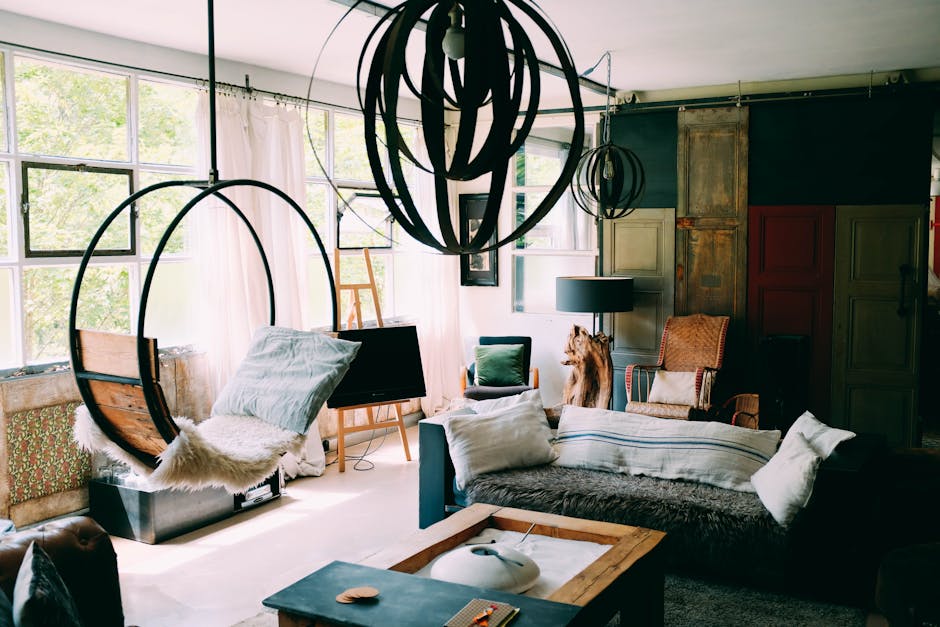Also, don't use the same first few words in adjacent paragraphs.
Decorating a living room that seamlessly flows into a kitchen presents a unique set of decorating challenges, and exciting decorating opportunities. It’s about creating a cohesive space where both areas feel distinct yet connected, stylish while also being functional. Thinking about how to successfully merge these two spaces can seem overwhelming, but by considering layout, style, color, and storage, its definitely achievable. We’ll go through essential aspects that will bring a stylish and cohesive design for a combined living room and kitchen area.
Defining Zones: The Key to Harmony
Layout is everything
How you arrange the furniture in the living room area is vital to clearly define the zones. For Example, orienting a large sectional sofa to face away from the kitchen creates a natural visual barrier. Consider these key furniture placement ideas:
- Anchor Furniture: Placing a large area rug beneath your seating area creates an unmistakable "living room zone." Its like drawing a line with textiles.
- Strategic Seating: Use armchairs, ottomans, or poufs to fill in the seating area. An intentional arrangement will say "This is where we relax," so make it say that.
- Traffic Flow: Ensuring easy traffic flow between the kitchen and living room is critical. Dont place objects that impede the natural walk-through pathways. Consider where people will usually walk from one area to another.
- Consider an Island with seating: An island in your kitchen provides counter space and casual dining, it can also act as a subtle partition between spaces.
Visual Dividers: Subtle Separation
Creating a visual division without completely blocking the view is a great solution for decorating. Here's some options:
- Partial Walls: A low wall, or even a half-wall, can subtly separate the spaces while maintaining an open feel.
- Bookshelves: Open bookshelves provide both storage and a visual barrier. They offer places to display books, plants, and decorative items, further defining the living room.
- Plants: Tall potted plants can create a natural green screen between the two zones, adding freshness and life to the whole space.
- Sliding doors: Sliding doors, especially glass ones, will provide an actual barrier for sound control as well.
- Screens: Decorative screens are portable and offer a flexible division solution and stylish aesthetic, but make sure it suits the design you're trying to create.
Color and Material Harmony: A Unified Vision
Achieving a unified look requires careful consideration of colors and materials in both the living room and kitchen. Lets explore ways to bring harmony into the design.
Consistent Color Palette
Selecting a cohesive color palette is paramount. You don't necessarily need to match colors exactly, but using complementary shades or a unified undertone will make everything feel connected.
- Neutral Foundation: Begin with a neutral base on walls (beige, gray, off-white). Then introduce colors through furniture, artwork, and accessories.
- Accent Colors: Choose 2-3 accent colors to repeat throughout both the kitchen and living room. These could be pops of blue in the kitchen backsplash and throw pillows in the living room, or yellow accents in the bar stools with artwork in the living room.
- Material Repetition: Echo materials across both spaces. For instance, if you have stainless steel appliances in the kitchen, introduce stainless steel accents in the living room like a lamp or coffee table base.
Lighting Design: Setting the Mood
Lighting plays a significant role in defining the mood and functionality of each zone. Kitchens need bright, task-oriented lighting, while living rooms benefit from softer, ambient light. Layering these can bring a cohesive approach.
- Kitchen Lighting: Recessed lighting for overall brightness, pendant lights over the island or breakfast bar, and under-cabinet lighting for task work are vital.
- Living Room Lighting: A combination of floor lamps, table lamps, and perhaps a chandelier (if it fits the height of the space) or wall sconces will create layers of light.
- Matching Fixtures: Choose lighting fixtures that complement each other in style and finish. If you have modern chrome pendants in the kitchen, consider a chrome floor lamp in the living room.
- Dimmers: Install dimmers in both zones to adjust the lighting as needed. This allows you to create a cozy atmosphere in the living room and a well-lit space for cooking.
Storage Solutions: Maximizing Space and Style
In an open-concept living room-kitchen, efficient storage is crucial to keep clutter at bay. Its also vital for style too! Because if you have a mess, your style is lost in it.
Living Room Storage Ideas
- Multi-Functional Furniture: A coffee table with hidden storage, an ottoman that doubles as a storage chest, or a sofa with built-in drawers can provide extra space without sacrificing style.
- Wall-Mounted Shelves: Floating shelves or wall-mounted cabinets offer storage for books, decorative items, and media consoles without taking up floor space.
- Baskets and Bins: Use decorative baskets and bins to conceal clutter. These can be stored on shelves or under tables.
Kitchen Storage Integration
- Open Shelving: Incorporate open shelving in the kitchen to display stylish dishware, glassware, or cookbooks. This adds a decorative element and can visually connect the kitchen to the living room.
- Pantry Solutions: A well-organized pantry is vital. Consider pull-out shelves, door-mounted racks, and clear containers to maximize space and visibility.
- Island Storage: Utilize the kitchen island for storage. Drawers, cabinets, or even a built-in wine rack can provide added functionality.
Flooring Considerations: Unifying or Dividing?
Flooring choice can either unify the open-concept space or subtly delineate the two areas. Here's the low down:
Same Flooring Throughout
Using the same flooring material throughout both the kitchen and living room creates a seamless, expansive feel. This is particularly effective in smaller spaces. Hardwood floors, laminate, tile, or vinyl are good options.
Transition Flooring
If you want to visually separate the areas, consider using different flooring in each zone. A kitchen might feature tile or vinyl for durability and ease of cleaning, while the living room could have hardwood or carpet for warmth and comfort. Ensure the transition is smooth and intentional:
- Area Rugs: Layering area rugs in the living room can delineate the space and add texture and pattern.
- Thresholds: Use a threshold strip or a decorative transition piece where the flooring changes to create a polished look.
Furniture Selection: Comfort and Style
The furniture choices should reflect both the style of the room and the functionality required. A great deal of thought goes into making sure your furnishings match your vibe, and are actually comfy, and can stand the test of everyday living.
Living Room Furniture
- Comfortable Seating: Prioritize comfortable seating arrangements. A large sectional sofa, armchairs, and ottomans can create a welcoming and inviting space.
- Coffee Table: A coffee table is a functional centerpiece. Choose one that complements the style of the room and offers storage if possible.
- Media Console: A media console houses your television and electronics. Select one that matches the room's style and provides ample storage.
- Side Tables: Side tables provide a surface for lamps, drinks, and other items. They can also add a decorative touch.
Kitchen Seating
- Bar Stools: If you have a kitchen island or breakfast bar, choose bar stools that are comfortable and stylish. Consider adjustable height stools for added flexibility.
- Dining Set: In smaller kitchens, a small dining set might fit nicely and provide a nice zone for informal dining and conversation.
Finishing Touches: Personalization and Cohesion
The final touches – artwork, accessories, and plants – add personality and complete the design. Its like adding the sauce and garnish to a main meal: vital.
Artwork and Wall Decor
- Unified Style: Choose artwork that complements the overall style of the room. If you have a modern kitchen, consider abstract or geometric artwork in the living room.
- Gallery Wall: A gallery wall can add visual interest and personality. Use a mix of framed prints, photographs, and decorative objects.
- Mirrors: Mirrors can make a space feel larger and brighter. Place a large mirror on a wall to reflect light and create depth.
Accessories and Decor
- Throw Pillows and Blankets: Add throw pillows and blankets to the sofa for comfort and style. Use colors and patterns that complement the room's palette.
- Rugs: Area rugs add warmth, texture, and pattern. Choose rugs that define the seating area and tie the room together.
- Decorative Objects: Display decorative objects on shelves, tables, and consoles. Choose items that reflect your personality and style.
Plants and Greenery
- Indoor Plants: Incorporate indoor plants to add life and freshness to the space. Choose plants that are easy to care for and complement the room's style.
- Hanging Plants: Hanging plants can add visual interest and create a sense of height.
- Herb Garden: If you enjoy cooking, consider starting an indoor herb garden. This adds a practical and decorative element to the kitchen.
Mistakes to Avoid when Decorating an Open Concept Living Room and Kitchen
A few missteps can lead to a disorganized or disjointed space. Here's what to steer clear of:
- Mismatching Styles: Mixing styles is fine, but ensure there's a common thread. A completely different style in one zone will feel jarring.
- Ignoring Scale: Furniture that's too large or too small will throw off the proportions of the room. Measure carefully and choose pieces that fit the space.
- Overcrowding: Avoid overcrowding the space with too much furniture or decor. Leave plenty of room to move around comfortably.
- Poor Lighting: Inadequate lighting can make a space feel dark and unwelcoming. Plan your lighting carefully and layer it appropriately.
- Neglecting Storage: Insufficient storage can lead to clutter. Maximize storage opportunities to keep the space tidy and organized.
Conclusion
Decorating a living room that opens into a kitchen requires careful planning and attention to detail. By defining zones, creating a cohesive color palette, maximizing storage, considering flooring, and adding personalized touches, you can create a space that is both stylish and functional. Avoid common decorating mistakes, and you'll end up with a harmonious and inviting living space. Remember, its all about finding the proper balance between both kitchen and living room functionality.
Last modified: June 14, 2025



